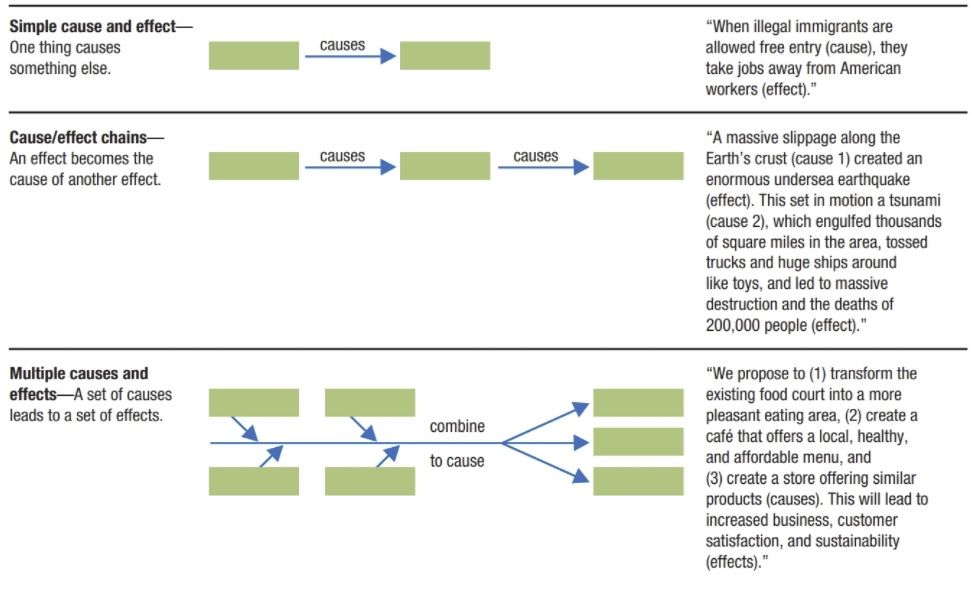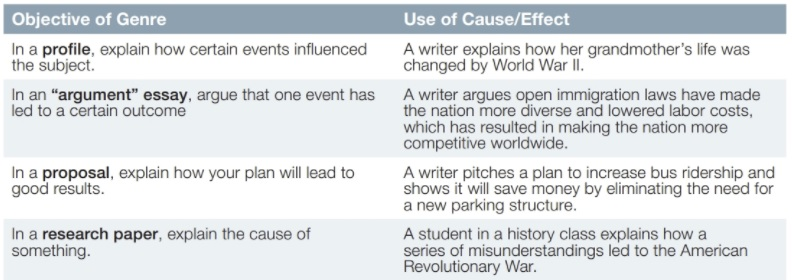6.4 Cause and Effect
Erin Thomas, MFA
Consequently …
Cause/Effect
Often writers see a cause and effect relationship developing in their drafts because pattern describes natural scientific relationships and patterns of the consequences of choices on the part of individuals, societies, and nations. Many things in the natural world and throughout history have a causal relationship, for example, the impact of water pollution on both humans and animals.[1]
Exploring causes and effects is a natural way to discuss many topics. Identifying causes is the best way to explain why something happened. Exploring the effects is a good way to describe what happened afterward. When authors use the cause and effect pattern, they identify both causes and effects and then choose one of the following relationships depicted in the graphic below to explain the relationship between them.

Even when describing a complex cause and effect scenario, you should try to present your analysis as clearly as possible. Often, the clearest analysis will resemble a narrative pattern, as in this analysis of tornado formation.
Although scientists still do not completely understand the causes behind the formation of tornadoes, most agree on this basic pattern. Three ingredients must be present: a large mass of warm moist air, a large mass of cold dry air, and a violent collision between the two. During springtime in the central United States, enormous masses of warm moist air can move rapidly northeastward from the Gulf of Mexico into what has become known as “tornado alley.” When the warm air collides with the cold air, thunderstorms are almost always produced. However, if the rapidly moving warm air slides under the cold air and gets trapped beneath, that’s when a tornado can occur. Because warm air is lighter than cold air, the warm-air mass will try to form something like a “drain” in the cold-air mass that would allow the warm air to shoot through. If this happens, a vortex of air develops, sucking everything on the ground upward at enormous velocities, causing the strongest winds produced anywhere in nature, up to 300 miles per hour. These powerful winds sometimes accomplish the unbelievable, such as uprooting enormous trees and driving pieces of straw through wooden planks.Type your textbox content here.
The chart below shows how different kinds of cause and effect analyses can be used in a variety of genres.

Cause/Effect Transitions
The tables below provide examples of expressions used to express cause and effect.
Table 6.3.1 Cause/Effect Expression, Function, and Example
| Expression | Function | Example |
|---|---|---|
| Consequently | Signals causal relationship | He was absent over 50% of the time and missed the final exam. Consequently, he failed the course. |
| Therefore | Signals causal relationship. Also signals a logical conclusion or reasonable inference. | He was absent over 50% of the time and missed the final exam. Therefore, he failed the course.He has failed several courses this year. Therefore, I think it’s likely that he’ll change his major. |
| For this/that reason | Signals causal relationship when reason is explicitly stated. | She was an excellent intern last summer. For this reason, I’m willing to hire her for the new full-time position. |
| Hence, Thus | Same as “therefore” but more formal. Both of these can be used to introduce phrases rather than complete sentences. | The grant is nearing the end of its cycle. Thus, we’re actively seeking funding.The grant is nearing the end of its cycle. Hence, the search for new funding. |
| In that case | Signals a conditional relationship, like if–>then | Water may reach flood stage by morning. In that case (if that happens), the National Guard will come to assist. |
Table 6.3.2 More Cause/Effect Transitions
| Cause/Effect Transitions | ||
|---|---|---|
| accordingly | so | another reason |
| because | then | comparably |
| as a result | since | in the same way |
Instructions
- Read through excerpts from “Isolationism vs. Interventionism”[4] (Excerpt 1 and Excerpt 2, below), which explain American sentiment surrounding participation in WWII.
- Circle the transition words/signal phrases in each selection.
- Identify the the cause and effect relationship in each of the texts. Then you will diagram the causes and effects in a method of your choice.
- You can diagram the causes and effects using boxes and arrows as demonstrated in this chapter.
- You can create a table similar to the cause and effect template below.
Cause-Effect Template
| Cause | Effect |
|---|---|
Excerpt 1
Although the U.S. had only entered World War I at the very end – nineteen months before the Treaty of Versailles – 70% Americans believed that joining the conflict was a mistake. As a result of the fighting, the poisonous gas, and the dismal conditions of the trenches, and the influenza pandemic, over 116,000 American soldiers had perished.
Identify the cause and effect relationship in this text, list the causes and effects, and diagram them in a method of your choice.
Excerpt 2
The Path to War
As Hitler continued his tirade across Europe, public opinion began to change. In the beginning of 1940, 88% of Americans opposed joining the war. In June, the number of citizens who supported helping the British had risen just a few points to 35%. Then the fall France jolted the nation awake. The Nazis focused the strength of their air force on blitz bombing of London, Liverpool, and Manchester every night from September to May to break the morale of the British people. Despite being out-planed, the Royal Air Force fought back courageously, showing that Hitler could be repelled. At the beginning of Hitler’s onslaught, many U.S. citizens changed their minds. More than half, 52% of Americans, felt it was worth the risk of war to provide aid to Britain. As the bombing campaign intensified, this increased to 68% by April of 1941.
Meanwhile, the war in the Pacific progressed. During 1939-1940, the U.S. began to cut its ties with Japan by ending its treaties and cutting off Japanese access to American steel, rubber, and oil. Despite being short resources, Japan continued to invade nations across the Pacific, naming the empire the “Greater East Asia Prosperity Sphere.” In response, the U.S. called upon Japan to relinquish the conquered territory in China. Military planners in Japan, as a consequence, considered American involvement in the war unavoidable, and launched the surprise attack on Pearl Harbor to give the Japanese forces time to prepare. The lives of 2400 Americans, many of them servicemen, were lost in the bombing, and the resistance of the isolationists collapsed. FDR declared war a few hours later with full support of Congress.
Identify the cause and effect relationship in this text, list the causes and effects, and diagram them in a method of your choice.
Media Attributions
- cause and effect © Pamela Bond is licensed under a CC BY-NC-SA (Attribution NonCommercial ShareAlike) license
- cause and effect 2 © Pamela Bond is licensed under a CC BY-NC-SA (Attribution NonCommercial ShareAlike) license
- Hutchison, N. (2020). English 087: Academic Advanced Writing. Pressbooks. https://pressbooks.howardcc.edu/engl087/chapter/rhetorical-modes/ ↵
- Bond, P. (2020). Power of the Pen. Pressbooks. https://pressbooks.pub/powerofthepen/chapter/__unknown__-7/ ↵
- Hutchison, N. (2020). English 087: Academic Advanced Writing. Pressbooks. https://pressbooks.howardcc.edu/engl087/chapter/transition-words-phrases/ ↵
- Thomas, E. (2025). Isolationism vs. interventionism. ↵

